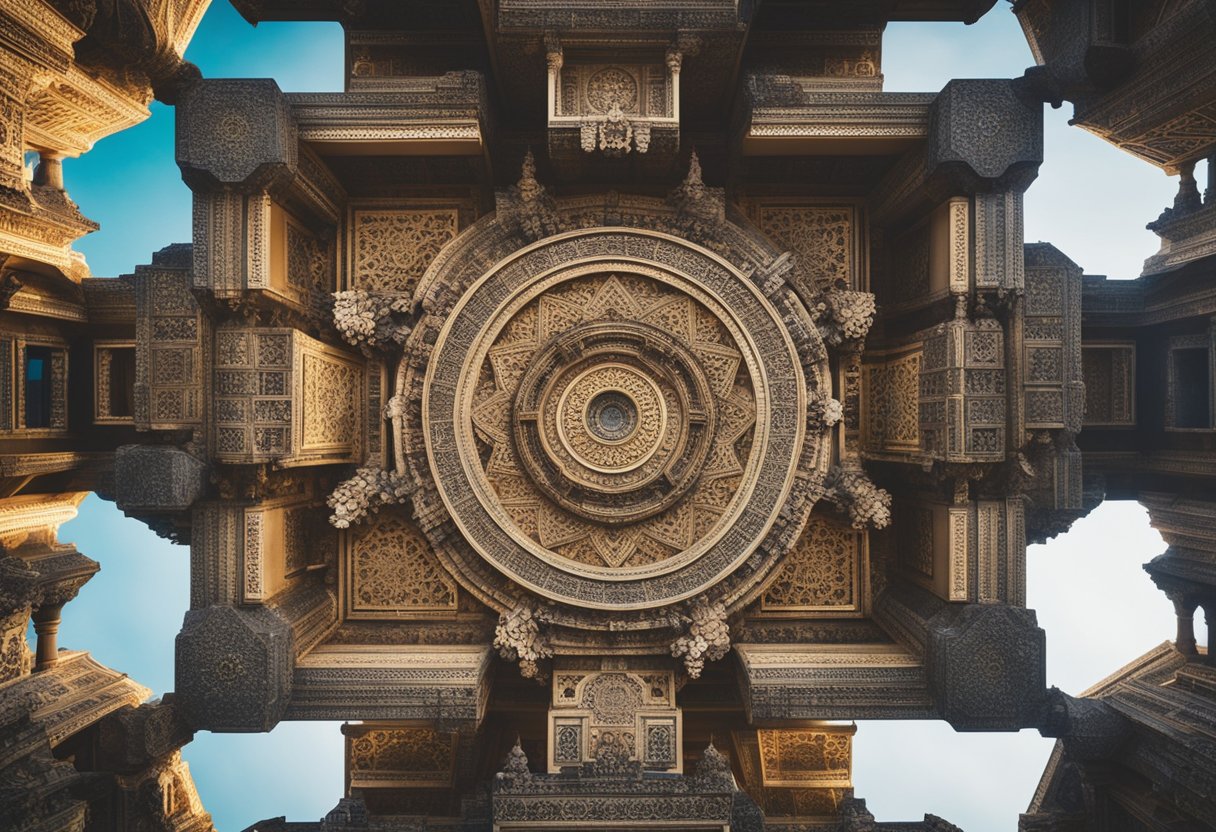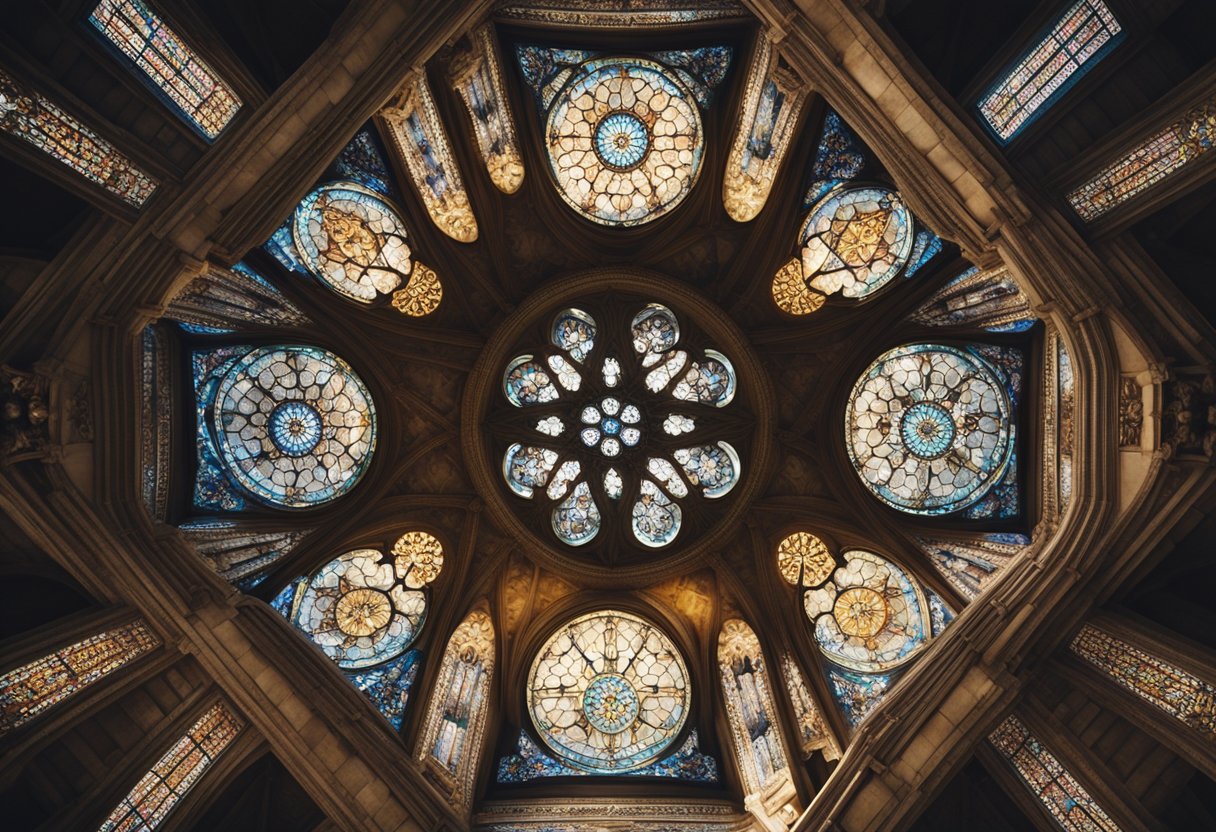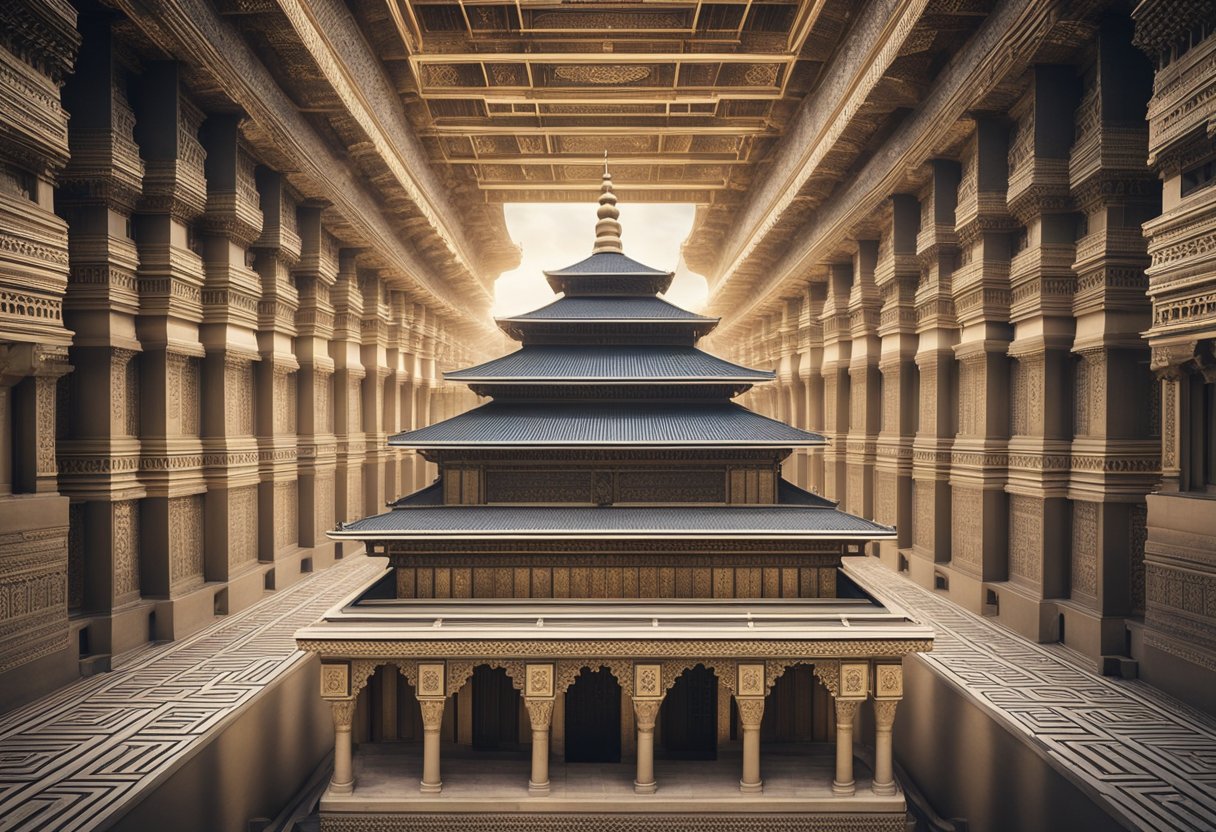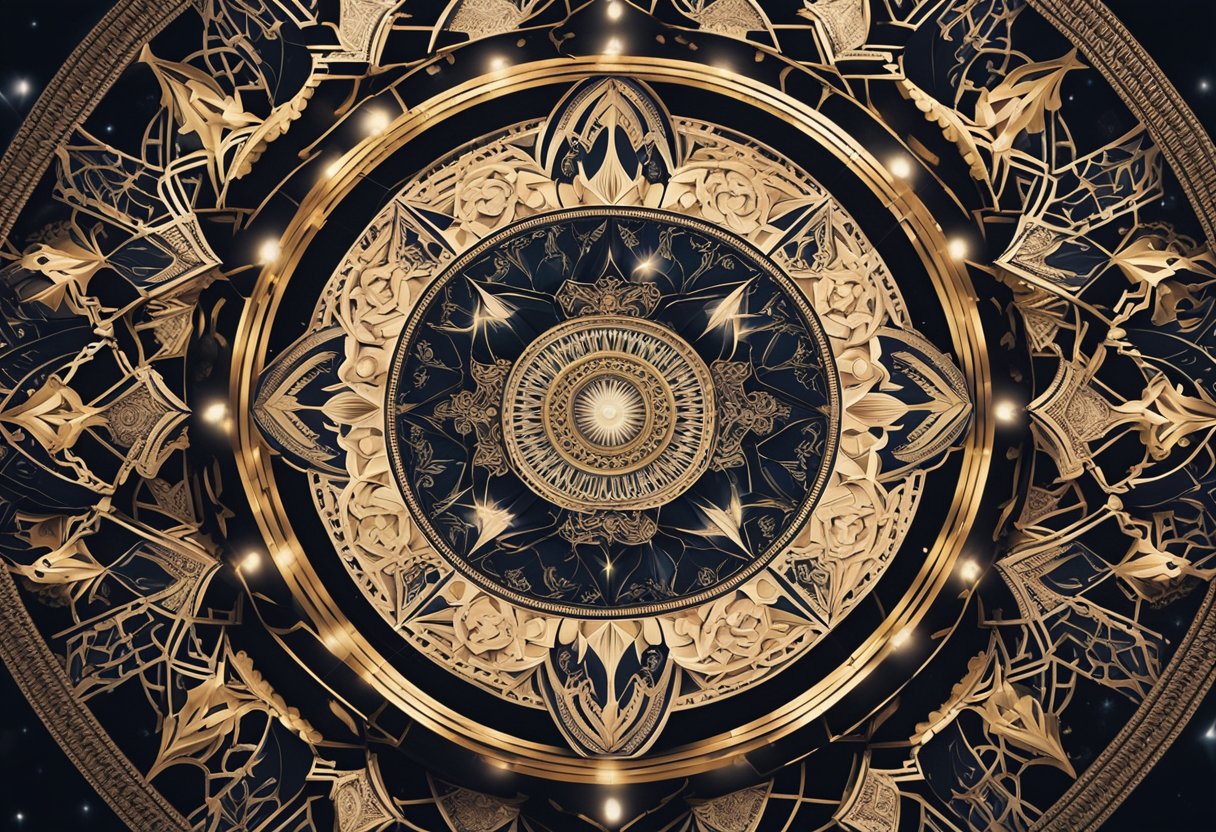Sacred Geometry Architectural Wonders of Antiquity

Updated On: April 24, 2024 by Aya Radwan
Sacred geometry is the mathematical rationale that underlies our world, manifesting in nature, art, and architectural marvels that stretch back to antiquity. This ancient science explores how shapes and patterns form the fundamental templates for everything in our universe. The ancients believed that by understanding these patterns, one could gain insight into the mysteries of creation. From the pyramids of Egypt to the spiralling nautilus shell, sacred geometry has been a source of wonder and inspiration, providing a common language across different cultures and epochs.
Sacred geometry architectural wonders of the past often encapsulated the concept of divine proportion, integrating sacred geometry into their foundations. We see this in the enduring legacy of temples, cathedrals, and monuments that reflect a harmony between human consciousness and the cosmos. These structures were not just feats of engineering; they were embodiments of spiritual principles and a testament to our ancestors’ quest to align their creations with the natural order of things.
Foundations of Sacred Geometry
Sacred geometry is the metaphysical principle ascribes symbolic and sacred significance to certain geometrical shapes and proportions. It is the foundation upon which many architectural wonders of the ancient world were constructed. In essence, sacred geometry is the blueprint of creation and underpins the entire universe, from the patterns of atomic structures to the immense scales of cosmic phenomena.
At the core of these principles lies the circle, a perfect shape representing energy’s infinite nature and the physical world’s closed boundary. The vesica piscis, a shape formed by the intersection of two circles with the same radius and the seed of life, is fundamental in the study of sacred geometry, highlighting the interconnectedness of life and the cosmos.
The golden ratio, also known as Phi, is a pivotal element in sacred geometry, appearing in everything from the spiral arrangement of leaves and flowers to the proportions of the human body and the Parthenon. The golden ratio defines an aesthetically pleasing harmony replicated throughout nature and human-made structures.
Successive points divide a line so that the whole is to the large part, and the large part is to the small part, producing a Fibonacci sequence. This sequence manifests in the natural world through the logarithmic spiral and can be observed in the growth patterns of many organisms.
The Platonic solids—tetrahedron, cube, octahedron, dodecahedron, and icosahedron—are the only perfectly symmetrical three-dimensional forms with identical faces and angles. They are believed to be the universe’s building blocks, representing the elements of earth, air, fire, water, and the cosmos.
Our study of sacred geometry extends beyond these shapes to a profound understanding of the foundational mathematics and its real-world applications in architecture, ranging from the pyramids of Egypt to the Gothic cathedrals of Europe.
By approaching sacred geometry as a toolkit for harmoniously designing and understanding our physical space and spiritual well-being, we honour the intelligence and intention embedded within our ancient monuments and the natural world.
Historical Perspectives
As we explore the architectural marvels of ancient times, it’s evident how societies like Greece, ancient Egypt, and India have shaped the historical narrative of sacred geometry.
Ancient Civilisations
The Greeks were instrumental in the evolution of architecture, infusing geometric harmony and proportion in their structures. The Parthenon is a prime example of this geometric precision. Across the Mediterranean, Ancient Egyptians utilised sacred geometry to construct the colossal pyramids, aligning them with celestial bodies with extraordinary accuracy. Meanwhile, the Indian subcontinent saw repetitive geometric designs like mandalas come to life within their temples, symbolic of the universe in Hindu and Buddhist iconography.
Influential Figures
Key individuals have perpetuated the use of sacred geometry in architecture. The mathematician Pythagoras from ancient Greece held that geometrical patterns were foundational to interpreting the universe. In India, architects known as Sthapatis followed specific guidelines outlined in ancient texts like the Vastu Shastra to create buildings in harmony with the cosmos.
Modern Implications
Today, these ancient approaches continue to influence modern architecture and urban planning. For instance, the harmonious designs seen in Greek and Egyptian constructions are echoed in some contemporary buildings that aim to replicate a similar balance and proportion. Sacred geometry is a fusion of science and spirituality, a testament to its universality and timelessness.
By aligning ourselves with these transcendent patterns, we tap into a collective understanding of balance, aesthetics, and cosmic order like the civilisations before us. Our appreciation of these ancient wonders is more than architectural interest—a connection to the shared legacy of human ingenuity.
Sacred Geometry Architectural Wonders: Religious Structures

Sacred geometry underpins the foundational structures of many religious monuments worldwide. This design philosophy encapsulates a divine belief in the geometry inherent in the natural world and its symbolic interpretation within sacred spaces.
Hindu Temples
Hindu temples are profound embodiments of sacred geometry, reflecting beliefs and the universe. The mandala, meaning ‘circle’ in Sanskrit, represents the cosmos metaphysically or symbolically and forms the basis for temple floor plans. Architecturally, these structures are outward manifestations of complex spiritual concepts, often designed to lead the devotee from the temporal world into a spiritual presence, invoking a connection with the divine.
Greek Parthenon
Regarded as architectural wonders, Greek Parthenons exhibit a refined use of sacred geometry, revealing the Greeks’ understanding of harmony and balance. The Parthenon in Athens, dedicated to the goddess Athena, is an exemplary model where proportions and columns were meticulously crafted to reflect perfection and aesthetic precision. Every aspect, from the columns’ spacing to the structure’s symmetry, incorporates mathematical ratios that echo the Greeks’ quest for harmony in architecture.
Christian Churches
In Christian churches, sacred geometry manifests through the incorporation of symbols like the Vesica Piscis – symbolic of Christ’s intersection with the earth. Gothic-style churches showcase a masterful exploration of spatial dimensions and divine proportionality. Notable examples like Notre Dame in Paris show architects’ use of sacred geometry to create an upward sense of momentum, directing the worshippers’ gaze towards the heavens.
Through these diverse religious structures – temples, Parthenons, and churches – sacred geometry serves as a bridge between the earthly and the ethereal, expressing the sanctity of places of worship and echoing the divine connection sought by those who venture within.
Geometric Shapes and Their Meanings

In the study of sacred geometry, geometric shapes and symbols hold profound meanings echoed in various manifestations of ancient architecture. These forms and representations speak to a universal language understood through the language of mathematics and spirituality.
Circles represent unity and infinity, often seen in mandalas, which symbolize the universe and wholeness. The Vesica Piscis, formed by two intersecting circles, is one of the simplest and most powerful symbols, signifying creation and the unity of opposite forces.
The Golden Ratio, a divine proportion found throughout nature, has been leveraged in constructing breathtaking architectural marvels, affirming the belief that this ratio creates aesthetic harmony. This ratio is also present in the spiral, commonly found in seashells and galaxies, denoting growth and continuous expansion.
We also venerate the Flower of Life, comprising multiple evenly-spaced, overlapping circles arranged in a flower-like pattern. This intricate symbol underscores the interconnectedness of life and serves as the blueprint for creating more complex geometries.
Platonic Solids, five regular polyhedral shapes, are revered as the building blocks of the world—each associated with an element of nature and embodying a perfect form. The Seed of Life is made from seven circles growing outward, symbolising the seven days of creation. It represents the fundamental forms of time and space. Lastly, Yantras are mystical diagrams that spiritual practitioners employ to focus and establish a higher state of consciousness.
Together, these shapes and symbols offer us a glimpse into the ancients’ profound understanding of the cosmos, laying the geometric foundations upon which their architectural wonders were built.
Divine Proportions in Art and Architecture
The concept of divine proportions, often termed the golden ratio, permeates the essence of art and architecture. Historically, this mathematical ratio of approximately 1.618 has symbolised beauty and harmony in design.
Artists and architects have employed this proportion to create aesthetically pleasing and naturally balanced works. The golden ratio can be vividly seen through Leonardo da Vinci’s Vitruvian Man. This iconic drawing demonstrates the blend of art and mathematics, featuring a human figure with ideal body proportions that fit within a circle and square—classic symbols of divine symmetry.
Similarly, the acclaimed Mona Lisa integrates these ratios subtly, influencing the layout and the engaging smile of the subject that has captivated viewers for centuries. This incorporation of the golden ratio in art illustrates how divine proportions are instrumental in achieving balance and beauty.
In architecture, divine proportions are core to the design of many historical structures. They give buildings a sense of permanence and order, aligning structures with the natural patterns found in their environment. By observing these patterns, we can appreciate the symbolic elements portrayed through architectural choices, tirelessly echoing the natural world’s elegant geometry.
We know that these timeless principles of sacred geometry continue to influence contemporary design, ensuring that the ancient wisdom of harmonious proportions remains alive in our modern world. The marriage of functionality and aesthetic sensibility in our built environments is a testament to our enduring pursuit of balance and beauty.
The Influence of Geometry in Nature

When we observe the natural world, we’re often struck by the intricate patterns and shapes that seem to recur almost endlessly. These are not random; they’re manifestations of geometric principles that have fascinated humans since antiquity. The Fibonacci spiral and Golden Ratio are prime examples of mathematics expressed in nature, adhering to a formula that achieves efficiency and beauty.
Take the nautilus shell, for example, whose growth pattern follows the Fibonacci sequence—an integer sequence where each number is the sum of the two preceding ones. This creates a spiral, which can also be observed in galaxies and hurricanes, indicating a cosmic uniformity governed by mathematics.
Another aspect of geometry in nature is the shapes of leaves and the formation of the sun’s rays that provide optimal light exposure. Even the petals of a flower often align with Fibonacci numbers, revealing a mathematical harmony at the heart of biology.
| Entity | Connection to Geometry in Nature |
|---|---|
| Nautilus Shell | Exemplifies Fibonacci spiral |
| Sun | Rays form radiating patterns |
| Golden Ratio | Found in various natural structures |
| Mathematical Principles | Govern growth patterns and structures |
Applying geometry within nature isn’t just aesthetically pleasing but serves fundamental functions that support life. Our understanding of these patterns and principles offers insights into the natural world and influences how we design and construct our environments, paying homage to the architectural wonders of the ancient world.
Geometry and the Human Connection

Geometry is deeply embedded in our existence, influencing our health, well-being, and spiritual relationships. It acts as a bridge between the tangible world and the intangible domains of energy and consciousness, impacting our lives on multiple levels.
Harmony and Well-being
In architecture, sacred geometry creates spaces that resonate with harmony and positive energy. It is believed to enhance the flow of chi, or life force, promoting balance and well-being. The principles of sacred geometry are often applied to the design of wellness spaces – for instance, in the layout and proportions of rooms intended to cultivate a calm and healing atmosphere. Interaction with these carefully crafted environments can deeply affect our mental and emotional states.
Geometry in the Human Body
The human body itself is a marvel of sacred geometry. The Vitruvian Man by Leonardo da Vinci epitomises this concept, encapsulating the idea that the proportions of the human body follow geometric ratios that are harmonious and universally found in nature. This synergy suggests that our innate connection with geometry extends to the fabric of our being, impacting our physical health and mirroring the symmetry observed in the natural world. These proportions are more than mere measurements; they reflect the intrinsic relationships that make up the cosmos and our connection to the spiritual realm.
Sacred Geometry in Modern Design and Architecture

We see the principles of Sacred Geometry echoed in contemporary design and architecture, where the focus on sustainability and innovation often draws from age-old wisdom.
Eco-friendly Architecture
In eco-friendly architecture, sacred geometry is aesthetic and serves a functional purpose. Buildings are designed to harmonise with the natural environment, incorporating elements like the Fibonacci Sequence to optimise sunlight and airflow. This approach, often in alignment with Vastu Shastra and Feng Shui, aims to create living spaces in ecological balance with the earth.
Innovative Building Concepts
Regarding innovative building concepts, some modern architects take inspiration from the mandala, a symbol representing the universe in Hindu and Buddhist symbolism, to create spaces that promote tranquillity and well-being. Notable past monuments inspire geometric proportions in buildings such as the United Nations building. Meanwhile, icons like the Farnsworth House by Mies van der Rohe illustrate how modernist architecture has embraced geometric simplicity and transparency. These concepts support modern architecture’s dedication to clean lines and sustainability by minimising new constructions’ ecological footprint.
The Interplay of Sacred Geometry and Science

Sacred geometry, the study of geometric shapes and their metaphysical significance, intricately ties with the science of implosion and bio-geometry. We find that mathematical principles, such as the Fibonacci sequence, penetrate through the seemingly disparate worlds of art and science, creating harmony in the natural and the constructed environments.
Take, for example, the Platonic solids—these perfect forms are not only fundamental in the philosophical works of Plato but also in the atomic structures that Johannes Kepler explored in his theories of the cosmos. We have the dodecahedron, a Platonic solid, embodying the Fibonacci sequence in its design. It is a pattern that unfolds in the growth spirals of pinecones and sunflowers, revealing the underlying order of nature.
The contributions of noted figures like Dan Winter emphasise the importance of understanding life forces through patterns in sacred geometry, advocating for a deeper exploration into the science of implosion, which is closely linked with the sustainability of life systems.
Let’s consider this in our systems:
- Geometry: Delivers foundational laws of the physical world.
- Science of implosion: Assesses energy patterns that sustain life.
- Biogeometry: Merges science with spiritual concepts to enhance life through design.
- Fibonacci sequence: Provides a mathematical link between nature’s aesthetics and its inherent efficiency.
- Platonic solids: Form the core structure of elements in both art and science.
- Johannes Kepler: Offered insights into celestial patterns and their geometric alignment.
Our understanding of science today continues to be shaped by these immutable geometric patterns, proving that these ancient principles still resonate in our modern scientific pursuits, illustrating the beautiful symphony between form, function, and the sacred.
Esoteric and Spiritual Dimensions of Geometry

Sacred geometry is a testament to the profound connection between the spiritual and physical worlds. We often find that geometric patterns are not merely visual motifs; they hold sacred meanings and serve as conduits for contemplation and meditation. In ancient civilisations, geometry was both an art form and a symbolic language infused with spiritual significance.
Symbolic Foundations:
- Geometry: Integral to the fabric of existence, reflecting unity and harmony.
- Technology: Subtly encoded in ancient tools, enhancing philosophical and spiritual inquiry.
- Spiritual Realm: Geometry as a bridge to higher states of consciousness.
Sacred Meanings:
- Each shape, such as the circle, square, or spiral, is symbolic of cosmological principles.
- The circle represents eternity and the infinite nature of the universe.
- The square symbolises the material plane and stability.
Working with sacred geometry is about acknowledging the interconnected nature of all things. It offers a technology of the spirit, which allows us to comprehend the ephemeral qualities of the universe. For practitioners of spiritual traditions, employing geometry in meditation is a pathway to enlightenment.
In architecture, this union of geometry and spirituality crystallised into the physical world. Structures from antiquity remain as testaments to this profound knowledge. By engaging with these ancient towers, we are not just viewing remnants of history but participating in the silent dialogue between our ancestors and the eternal.
Through the esoteric and spiritual dimensions of geometry, we unlock a timeless understanding of the cosmos, allowing us to seamlessly weave the spiritual into our technological advancements and reveal the hidden language of the universe in our material world.
Integrating Sacred Geometry into Daily Life

Incorporating sacred geometry into our daily lives can foster harmony and positive energy. It is more than mere shapes; it represents the building blocks of our universe. We can utilise these shapes and patterns in our lives to promote balance and well-being.
In Vastu Shastra and Feng Shui, sacred geometry is essential for aligning spaces with cosmic energies. By organising our homes and offices using these principles, we create a flow that enhances tranquillity and prosperity. Geometric patterns, like the Fibonacci sequence, are pleasing to the eye and resonate with the natural order.
Here’s how we can actively use sacred geometry:
- Art: Bringing paintings or sculptures into our space that embody sacred geometry adds aesthetic value and serves as a visual reminder of the interconnectedness of life.
- Decor: We might select furniture or decorative objects that reflect geometric harmony, contributing to a balanced atmosphere.
- Jewellery: Adorning ourselves with jewellery designed with sacred geometric patterns can be a daily touchstone for alignment.
- Mindfulness Practices: Even our meditative practices may be centred around these shapes, focusing on the endless loop of a spiral or the encompassing embrace of a circle.
In summary, sacred geometry can be potent in cultivating a space of equilibrium. By mindfully integrating these timeless patterns into our environment, we enhance our surroundings’ aesthetic appeal and tap into a source of age-old wisdom that has been aligning energies for centuries. Through this integration, we connect to a language that transcends cultures and time—a dialogue of harmony and balance.
Frequently Asked Questions
This section addresses common queries about sacred geometry and its role in ancient architectural marvels. These questions shed light on the principles and application of sacred geometry in the context of historic structures and their lasting influence on modern practices.
What constitutes sacred geometry within the architectural achievements of ancient civilisations?
Sacred geometry in ancient architecture refers to the intentional use of geometric patterns and shapes imbued with symbolic meanings. Often tied to the cosmology and worldview of the civilisation, these shapes and forms reoccur in famous structures and are believed to reflect a harmony between earthly and divine principles.
How has sacred geometry been applied in constructing historic places of worship?
Places of worship constructed by ancient civilisations frequently display sacred geometry in their design. These buildings often embody geometric proportions such as the golden ratio, which can be observed in their layout, facades and ornamentation, creating a sense of balance and aesthetic perfection that was aimed to elevate the spiritual experience.
Which ancient structures are considered prime examples of sacred geometry in architecture?
Structures like the Parthenon in Athens, the Egyptian pyramids, and the complex layout of Angkor Wat serve as prime examples of sacred geometry. The precise mathematical relationships in their designs reflect a deep understanding of geometric principles and their significance to the societies that crafted them.
Can you identify the relationship between sacred geometry and the designs of the ancient wonders?
The designs of ancient wonders often incorporate complex patterns, alignments, and spatial hierarchies that resonate with the principles of sacred geometry. From the positioning of the Egyptian pyramids to align with stellar constellations to the proportional elegance of Greek temples, sacred geometry forms a bridge between art, architecture, and perceived cosmic order.
In what ways has sacred geometry influenced modern architectural practices?
Sacred geometry influences modern architecture by integrating proportion, scale, and harmony. Today’s Architects often draw upon these timeless principles to create spaces that evoke a sense of connection and continuity with the past while pushing the boundaries of design and functionality.
What are the defining principles of sacred geometry observed in ancient architectural wonders?
The defining principles of sacred geometry observed in ancient architectural wonders include using fundamental shapes, interlocking patterns, and the golden ratio to create a meaningful sense of order and proportion. These principles underpinned the design process, reflecting aesthetic preferences and spiritual or symbolic considerations.






